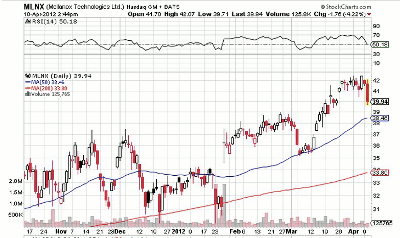As earnings season kicks off, plenty of small caps could sneak under investors’ radar. Although these stocks are not media darlings, they can potentially offer opportunity to investors and swing traders, writes MoneyShow.com contributor Kate Stalter.
With earnings season upon us, the majority of attention this week will be centered on big caps like Alcoa (AA), JPMorgan (JPM), Wells Fargo (WFC), and Google (GOOG).
That makes sense, of course, since large, widely held names have potential to move markets with either good or bad surprises. In addition, plenty of investors have exposure to these stocks through mutual funds or indexed ETFs.
But there are a number of small-cap names also reporting this month. While they are not typically market movers, their quarterly results can send individual names—and even industry peers—sharply up or down.
The general market is in a downturn, and small caps tend to pull back at even greater rates than the benchmark index. They are often thinly traded, with high betas, so it’s not surprising to see that kind of action.
Of course, the reverse is also true: Small caps and low-priced stocks often lead the way out of a market correction, offering some outstanding buy opportunities in the early days of a new market uptrend.
That’s why small caps are worth tracking during earnings season—even though the broader market is not flashing buy signals at the moment.
Titan Machinery (TITN) is one of those companies that has a promising chart and fundamentals, but is unlikely to grab headlines. It’s a North Dakota-based retailer of agricultural gear.
The stock is up more than 29% year-to-date. Its 2011 correction was steep, and easily undercut the prior consolidation’s lows. Currently, the stock is getting support above its ten-week average, and as of Tuesday, was perched near its ten-day line.
Analysts expect quarterly income of 53 cents per share on revenue of $438.94 million. That would mark year-over-year increases on the top and bottom lines.
Looking at Titan’s chart, a new buy point could occur as the stock clears its previous 2012 high of $29.47. In a bull market, that type of action in an individual stock is less risky, because about 75% of stocks trend in tandem with the market.
However, in a market downturn, there’s greater risk that a stock will quickly retrace post-earnings price gains.
Turning to another stock set to report this month, Israel-based chip designer Mellanox (MLNX) has confirmed that it will report its first quarter on April 18, after Wall Street’s closing bell.
It’s seen earning 34 cents per share on revenue of $81.6 million, year-over-year increases in both cases.
Mellanox is another small stock that has staged a healthy run-up so far this year, advancing more than 22%. It has retreated with the market correction this month, and sliced its 20-day line in a steep pullback on Tuesday.
|pagebreak|While those sharp declines are attention-grabbers, and can be devastating to extremely short-term holders, investors and traders with slightly longer time horizons—for example, weeks, rather than days or hours—can observe possible opportunities in such moves.
Frequently, institutional owners, such as fund managers, will step in to purchase more shares of a stock they already own as it pulls back. This is why support at the ten-week moving average is such a frequent occurrence, before a stock resumes its uptrend.
As shares rebound off that line, more aggressive individual investors can buy near that level. More conservative investors, who prefer further proof of institutional buying, may want to wait until the stock clears its prior high.
Another small cap that reports this month is much better known to US consumers. Chicken wing purveyor Buffalo Wild Wings (BWLD) has confirmed that it would report on April 24, after the close.
Analysts have pegged first-quarter earnings at 95 cents a share on revenue of $251.15 million—significant increases on both ledger lines.
The stock has struggled in recent weeks, along with the general market. On April 2, it gapped down nearly 3% in heavy volume following a Raymond James downgrade.
Often, the effects of a downgrade are relatively short lived. However, the broader market pullback can and will drag down even strong stocks—so a name that’s already under selling pressure could see that downward trend continue.
As of Tuesday, the stock was getting support just at its 50-day line—a potentially bullish sign. This stock has a strong record of fundamentals and technicals. It has gained 26.31% year-to-date. As with many other stocks, and, indeed, with the general market, a pullback at this juncture is not out of the ordinary.
A potential buy point could occur above the stock’s March 27 intraday high of $94.81. However, even with a good earnings report, the stock could meander below that high as long as the market conditions remain weak.
At the time of publication, Kate Stalter did not own positions in any stock mentioned in this column.
Related Reading:













